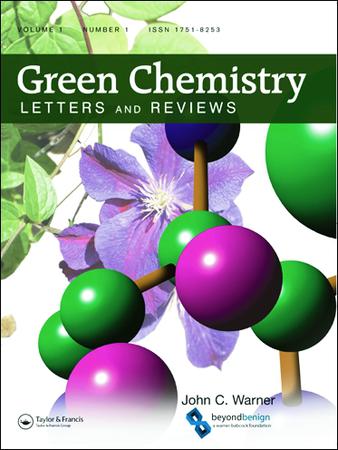以木质素衍生单体为原料无溶剂合成光致发光纳米碳
IF 5.8
3区 化学
Q1 CHEMISTRY, MULTIDISCIPLINARY
引用次数: 0
摘要
本文章由计算机程序翻译,如有差异,请以英文原文为准。
Solvent-free synthesis of photoluminescent carbon nanoparticles from lignin-derived monomers as feedstock
ABSTRACT Photoluminescent carbon nanoparticles (CNPs), such as carbon dots (CDs), have attracted much attention owing to a unique set of properties, like high and tunable fluorescence. In this way, the use of carbon-rich lignin has been demonstrated to be a sustainable approach to producing a broad range of photoluminescent CNPs. However, the valorization of this complex polyphenol is limited when it comes to green and efficient ways of conversion. In addition, the existing solvothermal approaches using lignin often result in CDs with low photoluminescence, while flammable and/or toxic solvents are employed. Here, we depolymerized technical lignins, i.e. kraft and soda, through electroreductive cleavage in two different sustainable media: deep eutectic solvent and levulinic acid. After depolymerization, lignin-derived monomers were generated, with a predominance of aryl ether and phenolic groups, which were further combined with 1,2-Phenylenediamine to produce N-doped CNPs in a solvent-free approach. Photoluminescent CNPs with varied sizes were generated (5–50 nm), which presented a wide photoluminescence emission, from blue to red, depending on solvent polarity. These results demonstrate a feasible and sustainable route for the solvent-free synthesis of photoluminescent CNPs using lignin-derived monomers as carbon source, which may find applications in a wide range of fields. GRAPHICAL ABSTRACT
求助全文
通过发布文献求助,成功后即可免费获取论文全文。
去求助
来源期刊

Green Chemistry Letters and Reviews
CHEMISTRY, MULTIDISCIPLINARY-GREEN & SUSTAINABLE SCIENCE & TECHNOLOGY
CiteScore
9.10
自引率
3.00%
发文量
48
期刊介绍:
Green Chemistry Letters and Reviews is an Open Access, peer-reviewed journal focused on rapid publication of innovative new syntheses and procedures that reduce or eliminate the use and generation of hazardous materials. Reviews of state-of-the-art green chemistry technologies are also included within the journal''s scope.
Green Chemistry Letters and Reviews is divided into three overlapping topic areas: research, education, and industrial implementation. The journal publishes both letters, which concisely communicate the most time-sensitive results, and reviews, which aid researchers in understanding the state of science on important green chemistry topics. Submissions are encouraged which apply the 12 principles of green chemistry to:
-Green Chemistry Education-
Synthetic Reaction Pathways-
Research and Process Analytical Techniques-
Separation and Purification Technologies-
Renewable Feedstocks-
Degradable Products
 求助内容:
求助内容: 应助结果提醒方式:
应助结果提醒方式:


